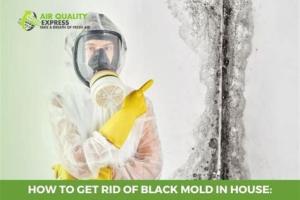How to Safely and Effectively Get Rid of Black Mold: A Comprehensive Guide

-
Quick Links:
- Introduction
- Understanding Black Mold
- Health Risks Associated with Black Mold
- Identifying Black Mold
- Preventing Black Mold Growth
- Effective Removal Methods
- When to Seek Professional Help
- Case Studies
- Expert Insights
- FAQs
Introduction
Black mold, scientifically known as Stachybotrys chartarum, is a toxic fungus that thrives in damp, poorly ventilated areas. It can pose serious health risks to humans and pets, making its removal essential for maintaining a safe living environment.
Understanding Black Mold
Black mold is not just an aesthetic nuisance; it can lead to severe health issues. It typically appears as black or dark green patches and releases allergens and irritants. Its spores can easily become airborne, spreading throughout your home.
How Black Mold Grows
- Moisture: Excess humidity or water damage.
- Organic Material: Materials like wood, drywall, and fabric.
- Poor Ventilation: Areas lacking airflow.
Health Risks Associated with Black Mold
Exposure to black mold can result in a variety of health issues, particularly for those with respiratory conditions, allergies, or weakened immune systems.
Common Symptoms of Exposure
- Respiratory problems (coughing, wheezing)
- Eye irritation
- Skin rashes
- Fatigue and headaches
Identifying Black Mold
Identifying black mold early on is crucial to prevent severe infestations. Here are some signs to look for:
Visual Signs
- Dark spots on walls, ceilings, or floors.
- Musty odors.
- Water damage or stains.
Preventing Black Mold Growth
Prevention is the best strategy against black mold. Here’s how to keep your home mold-free:
Humidity Control
- Use dehumidifiers in damp areas.
- Ventilate bathrooms and kitchens properly.
Water Damage Repair
Address leaks and water damage promptly to minimize mold growth.
Effective Removal Methods
Once black mold is identified, it must be removed safely and effectively. Here’s a step-by-step guide to do just that:
Step 1: Gather Your Supplies
- Protective gear (gloves, mask, goggles)
- Mold removal solution (vinegar, hydrogen peroxide)
- Scrub brush and sponge
- Trash bags
Step 2: Isolate the Affected Area
Close off the area to prevent spores from spreading to other parts of your home.
Step 3: Apply Mold Removal Solution
Use a spray bottle to apply your chosen mold removal solution directly onto the affected areas.
Step 4: Scrub and Remove Mold
Using a scrub brush, scrub the area until all mold is removed. Dispose of any materials that cannot be cleaned.
Step 5: Dry the Area Thoroughly
Ensure the area is completely dried to prevent mold from returning.
When to Seek Professional Help
If the mold covers a large area (greater than 10 square feet) or if you suspect it has penetrated your walls or flooring, it’s best to consult a professional mold remediation service.
Case Studies
Understanding real-world examples can provide insight into effective mold remediation strategies.
Case Study 1: Residential Mold Remediation
A homeowner discovered black mold in their basement due to a leaking pipe. After following the DIY removal guide and implementing moisture control measures, they successfully eliminated the mold.
Case Study 2: Professional Intervention
In another case, a school facility faced extensive mold growth due to prolonged water damage. They hired professionals who utilized industrial-grade solutions and equipment to remediate the issue effectively.
Expert Insights
Experts emphasize the importance of regular inspections and maintenance to prevent mold growth. They recommend using air purifiers and maintaining low indoor humidity levels.
FAQs
1. What causes black mold to grow?
Black mold thrives in damp, humid conditions, often due to water damage or high humidity levels.
2. How can I safely remove black mold?
Use protective gear, apply a mold removal solution, scrub the area, and ensure thorough drying.
3. Can I remove black mold myself?
Yes, but only if the affected area is small. For large infestations, seek professional help.
4. How do I prevent black mold from returning?
Control humidity levels, repair leaks promptly, and ensure proper ventilation.
5. What health risks does black mold pose?
It can cause respiratory issues, allergic reactions, and other health problems, especially in vulnerable individuals.
6. How long does it take to remove black mold?
The time varies based on the extent of the infestation but can range from a few hours to several days.
7. Do I need to discard items affected by black mold?
Items that cannot be cleaned thoroughly (like carpets or porous materials) should be discarded.
8. Is black mold always toxic?
Not all black mold is toxic, but Stachybotrys chartarum can produce mycotoxins that are harmful.
9. Can I use bleach to kill black mold?
Bleach can kill surface mold but may not penetrate porous materials, making it less effective for deep-rooted mold.
10. When should I consult a professional for mold removal?
If the mold covers a large area or if you have health concerns, it's best to seek professional help.
Random Reads